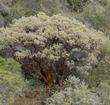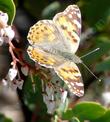Arctostaphylos viscida var. ssp. viscida
Whiteleaf manzanita.
Whiteleaf manzanita, Arctostaphylos viscida, grows from Kern County north to about the Oregon Border. It is not very garden tolerant but easily grown in native gardens. In the Sierra Nevada it is a common chaparral component. The gray foliage and red bark make a showy planting amongst boulders with a mulch layer. The leaf blade on subspecies viscida is glabrous and smooth. Excellent combined with oaks or pines. Commonly found on red clay and decomposed granite, but also lives on serpentine.
Associated plants range from Pinus sabiniana with Fraxinus dipetala, Rhamnus ilicifolia, Rhus trilobata, Quercus Wislizenii, Cercocarpus betuloides, Ceanothus cuneatus, Quercus douglasii to Pinus ponderosa with Libocedrus decurrens .
Arctostaphylos viscida is very similar to Arctostaphylos. mariposa. Ironically Arctostaphylos mariposa is the more hairy and glandular. A. viscida is generally the less drought tolerant than Arctostaphylos mariposa and generally occurs at 3000-5000 ft. Arctostaphylos mariposa is now considered a subspecies of Arctostaphylos viscida.
Associated plants range from Pinus sabiniana with Fraxinus dipetala, Rhamnus ilicifolia, Rhus trilobata, Quercus Wislizenii, Cercocarpus betuloides, Ceanothus cuneatus, Quercus douglasii to Pinus ponderosa with Libocedrus decurrens .
Arctostaphylos viscida is very similar to Arctostaphylos. mariposa. Ironically Arctostaphylos mariposa is the more hairy and glandular. A. viscida is generally the less drought tolerant than Arctostaphylos mariposa and generally occurs at 3000-5000 ft. Arctostaphylos mariposa is now considered a subspecies of Arctostaphylos viscida.
Arctostaphylos viscida var. ssp. viscida tolerates serpentine.
Arctostaphylos viscida var. ssp. viscida is great for a bird garden.
Foliage of Arctostaphylos viscida var. ssp. viscida has color gray and is evergreen.
Flower of Arctostaphylos viscida var. ssp. viscida has color white.
Fruit of Arctostaphylos viscida var. ssp. viscida is edible.
Communities for Arctostaphylos viscida var. ssp. viscida:Chaparral, Yellow Pine Forest and Central Oak Woodland.
| ph: | 6.00 to 7.80 |
|---|---|
| usda: | 7 to 10 |
| height[m]: | 1.00 to 4.00 |
| width[m]: | 1.00 to 3.00 |
| rainfall[cm]: | 60.00 to 107.00 |






 play movie
play movie
 play movie
play movie


